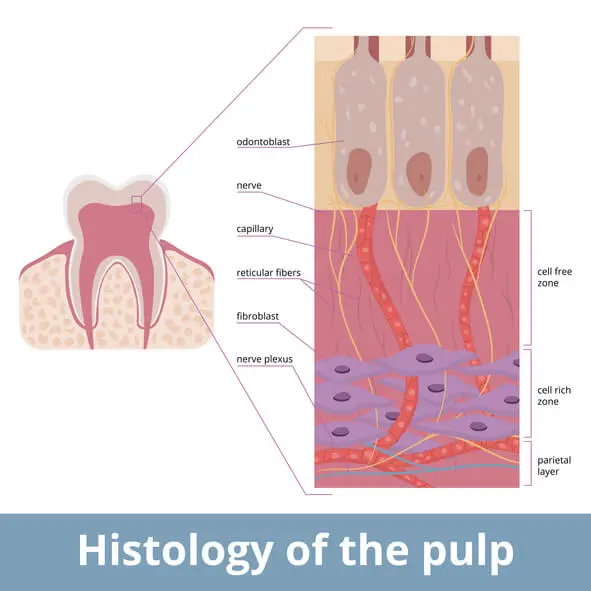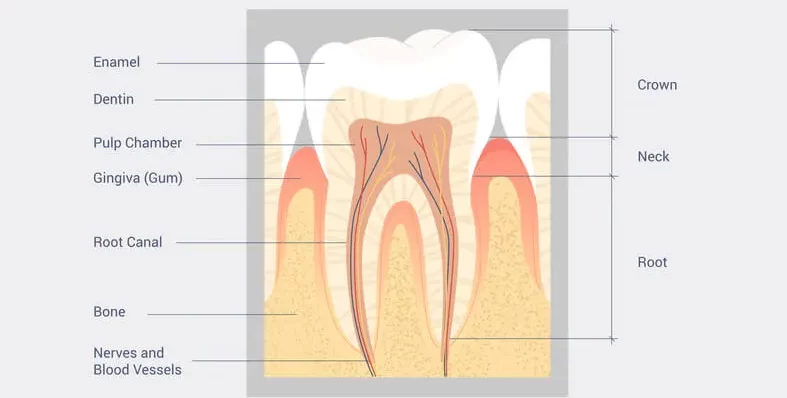When it comes to oral health, the tooth is a complex structure composed of several layers, each playing a crucial role in maintaining its function and integrity. Among these layers, the tooth pulp stands out as a vital component, essential for the vitality and health of the tooth itself. In this comprehensive article, we’ll delve deep into the intricacies of tooth pulp, exploring its anatomy, functions, common issues, and treatments.
Table of Contents
ToggleAnatomy of Tooth Pulp
The tooth pulp resides at the core of the tooth, housed within the pulp chamber and extending through narrow canals called root canals. This soft tissue is comprised of blood vessels, nerves, and connective tissues. It’s encased within the hard, mineralized layers of dentin and enamel, providing nourishment, sensory functions, and defense mechanisms for the tooth.
Pulp Chamber and Root Canals
- Pulp Chamber: Located at the center of the tooth, the pulp chamber is the larger portion found in the crown (top part) of the tooth.
- Root Canals: These are narrow, elongated channels that extend from the pulp chamber down to the roots of the tooth. The number of root canals varies depending on the tooth; some teeth have multiple canals.
Components of Tooth Pulp
- Odontoblasts
- Blood Vessels
- Nerves
- Connective Tissues
Odontoblasts
These specialized cells line the border between the pulp and dentin. They are responsible for the production of dentin, the hard tissue that forms the bulk of the tooth.
Blood Vessels
The pulp contains an intricate network of blood vessels that supply nutrients and oxygen to the tooth, supporting its growth, development, and repair processes.
Nerves
Nerve fibers in the pulp transmit sensory information such as pain, pressure, and temperature. They act as a warning system, alerting individuals to potential dental issues.
Connective Tissues
Fibrous connective tissues within the pulp provide structural support and help maintain the overall integrity of the tooth structure.
Pulp-Dentin Complex
The relationship between the pulp and dentin is crucial for tooth function and health:
Dentin-Pulp Interface
Dentin surrounds the pulp and serves as a protective barrier. It’s a hard, mineralized tissue that forms the bulk of the tooth structure, providing support and protection to the sensitive pulp.
Dentin Tubules
These microscopic channels within dentin transmit sensory signals from the outer layers of the tooth to the nerves within the pulp, contributing to the tooth’s sensitivity.
Histology of Tooth Pulp

Cellular Components
- Odontoblasts
- Fibroblasts
- Undifferentiated Mesenchymal Cells
- Defense Cells
Odontoblasts
Positioned along the periphery of the pulp, these specialized cells form a layer adjacent to the dentin. They play a pivotal role in dentinogenesis—the formation and maintenance of dentin throughout life.
Fibroblasts
These cells are abundant in the pulp and are responsible for synthesizing and maintaining the extracellular matrix, contributing to the structural integrity of the tissue.
Undifferentiated Mesenchymal Cells
These cells possess the potential to differentiate into various cell types as needed, playing a role in tissue repair and regeneration within the pulp.
Defense Cells
Various immune cells, including macrophages and lymphocytes, are present in the pulp. They play a role in the immune response, defending against infections or foreign substances that might penetrate the tooth.
Extracellular Matrix (ECM)
- Ground Substance
- Collagen Fibers
Ground Substance
The ECM of the pulp consists of a gel-like ground substance composed of water, glycosaminoglycans, and proteoglycans. It provides support and a medium for cell communication.
Collagen Fibers
Predominantly type I collagen fibers form the structural framework within the pulp, providing tensile strength and support.
Vascular and Nerve Supply
- Blood Vessels
- Nerve Fibers
Blood Vessels
The pulp is highly vascularized, containing a network of arterioles, venules, and capillaries. This rich blood supply provides nutrients and oxygen to the cells within the pulp.
Nerve Fibers
Innervation within the pulp comprises sensory nerve fibers, mainly belonging to the trigeminal nerve. These nerve fibers transmit pain, pressure, and temperature sensations.
Functions of Tooth Pulp
- Nutrient Supply
- Sensory Function
- Dentin Formation
- Immunological Response
Nutrient Supply
The pulp contains blood vessels that supply vital nutrients to the tooth, ensuring its growth, development, and overall health.
Sensory Function
Nerves within the pulp are responsible for the sensation of pain, pressure, and temperature. They act as warning systems, alerting individuals to potential issues such as cavities or infections.
Dentin Formation
Odontoblasts, specialized cells within the pulp, generate dentin, a calcified tissue that makes up the bulk of the tooth structure. This ongoing dentin production helps in repairing and fortifying the tooth in response to damage or decay.
Immunological Response
The pulp plays a role in the immune defense of the tooth. In case of infection or injury, the pulp initiates an immune response to fight against invading bacteria or pathogens.
Common Issues Affecting Tooth Pulp
Several factors can compromise the health and integrity of the tooth pulp, leading to various dental problems:
- Tooth Decay: When bacteria attack the tooth’s outer layers (enamel and dentin), they can progress deeper into the pulp, causing inflammation and infection known as pulpitis.
- Dental Trauma: Accidents or injuries to the tooth can result in fractures or cracks that expose the pulp, making it susceptible to bacterial invasion and subsequent infection.
- Dental Procedures: Certain dental treatments, such as deep fillings, multiple restorations, or repeated dental work on the same tooth, may irritate or damage the pulp, leading to inflammation or infection.
Complications and Risks Associated with Pulp Problems
Untreated or poorly managed issues related to tooth pulp can lead to various complications:
- Abscess Formation
- Spread of Infection
- Chronic Pain
Abscess Formation
Prolonged inflammation or infection within the pulp can lead to the formation of a dental abscess, a pus-filled pocket at the root of the tooth. This can cause severe pain, swelling, and even systemic health issues if left untreated.
Spread of Infection
If the infection within the pulp spreads beyond the tooth, it can affect surrounding tissues, leading to conditions like cellulitis or osteomyelitis, potentially requiring more extensive treatments or surgical interventions.
Chronic Pain
Persistent pulpitis or unresolved pulp issues can lead to chronic toothache, impacting daily life and overall well-being.
Diagnosis and Treatment
Diagnosing issues related to tooth pulp involves a thorough examination by a dentist, often utilizing X-rays to visualize the extent of damage or infection. Treatment options vary based on the severity of the condition:
- Root Canal Therapy
- Pulpotomy
- Pulp Capping
- Extraction
Root Canal Therapy
This procedure involves removing the infected or damaged pulp tissue, cleaning the canals, and sealing them to prevent further infection. It’s a highly effective way to save a tooth that would otherwise require extraction.
Pulpotomy
Pulpotomy commonly performed on children with deep cavities, this procedure involves removing the infected portion of the pulp, usually in the crown of the tooth, while leaving the healthy portion intact.
Pulp Capping
In cases of mild pulp exposure due to trauma or decay, a dentist might perform pulp capping by placing a medicated material over the exposed pulp to encourage healing and protect it from further damage.
Extraction
In severe cases of irreparable pulp damage or infection, extraction of the tooth might be necessary to prevent the spread of infection to surrounding tissues.
Advancements in Pulp Therapy
Recent advancements in dentistry have introduced innovative techniques and materials aimed at enhancing pulp therapy outcomes:
- Regenerative Endodontics
- Bioceramic Materials
- Improved Imaging Techniques
Regenerative Endodontics
This evolving field focuses on regenerating damaged or diseased pulp tissues. Techniques involving stem cells, growth factors, and scaffolds aim to stimulate the regeneration of pulp-like tissue within the root canal space.
Bioceramic Materials
Dentists now use biocompatible materials like bioceramics for root canal fillings. These materials provide better sealing properties, reducing the risk of reinfection and promoting healing within the treated tooth.
Improved Imaging Techniques
Advanced imaging technologies such as Cone Beam Computed Tomography (CBCT) offer precise three-dimensional visualization of tooth anatomy, aiding in accurate diagnosis and treatment planning for complex cases involving the pulp.
Conclusion
The tooth pulp, though often overlooked, plays a crucial role in maintaining the health and function of the tooth. Understanding its significance, along with adopting proper oral hygiene practices and seeking timely dental care, can significantly contribute to preserving the vitality of this essential dental component, ensuring a healthy smile for years to come.

